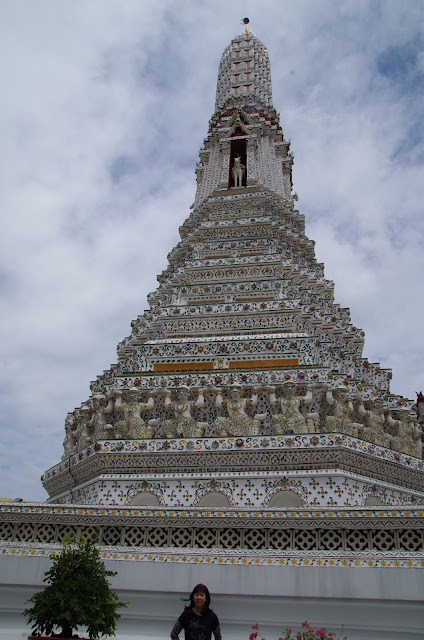Despite being under construction, I was glad we visited Wat Arun. Beautiful temple ornated with colourful porcelain.
Extract from Wikipedia
Architecture
The main feature of Wat Arun is its central prang (Khmer-style tower) which is encrusted with colourful porcelain. This is interpreted as a stupa-like pagoda encrusted with coloured faience. The height is reported by different sources as between 66.8 m (219 ft) and 86 m (282 ft). The corners are surrounded by four smaller satellite prang. The prang are decorated by seashells and bits of porcelain which had previously been used as ballast by boats coming to Bangkok from China.
The presiding Buddha image, cast in the reign of Rama II, is said to have been moulded by the king himself. The ashes of King Rama II are interred in the base of the image.
Construction of the tall prang and four smaller ones was started by King Rama II during 1809-1824 and completed by King Rama III (1824–1851). The towers are supported by rows of demons and monkeys. Very steep and narrow steps lead to a balcony high on the central tower. The circumference of the base of the structure is 234 metres, and the central prang is 250 feet high. The central prang is topped with a seven-pronged trident, referred to by many sources as the "Trident of Shiva". Around the base of the prang are various figures of ancient Chinese soldiers and animals. Over the second terrace are four statues of the Hindu god Indra riding on Erawan.
In the Buddhist iconography, the central prang is considered to have three symbolic levels—base for Traiphum indicating all realms of existence, middle for Tavatimsa where all desires are gratified and top denoting Devaphum indicating six heavens within seven realms of happiness. At the riverside are six pavilions (sala) in Chinese style. The pavilions are made of green granite and contain landing bridges.
Next to the prang is the Ordination Hall with a Niramitr Buddha image supposedly designed by King Rama II. The front entrance of the Ordination Hall has a roof with a central spire, decorated in coloured ceramic and stuccowork sheated in coloured china. There are two demons, or temple guardian figures, in front. The murals were created during the reign of Rama V.




























No comments:
Post a Comment